Put simply, 2010 was a monster year for cookbooks. It's the last thing you'd expect in the heyday of the food blog, the TV tie-in, the crowd-sourced recipe. But what we have here is an overwhelming display of carefully crafted books produced after years of research, recipe-testing and tireless detective work.
These labors of love -- for the most part written or edited by women -- are the work of cooks who not only have a remarkable, monklike ability to delve into their subject precisely and thoroughly, but also have a passion for sharing it.
We have cookbooks that take on whole lives at one go -- the memoirs of one food columnist, the life stories of a veteran cook and religious culture taken root in France; 70 years of one publication, 150 of another -- and in one mindblowing, fantastically ambitious case, the life of an entire country as it cooks and eats today. These books haven't just captured the cultural memory of their subjects; they're creating it as well.
There's one more perk, as if one were needed: These are the work of real-life cooks, who are food writers, small-business owners and moms first -- famous, second. That means every recipe is human-sized, and every recipe actually works. This year's books are like a properly seasoned skillet -- heavy-duty, battle-tested and much to be prized.
So give them a big hand, folks -- and then tie on your aprons. You're going to need them.
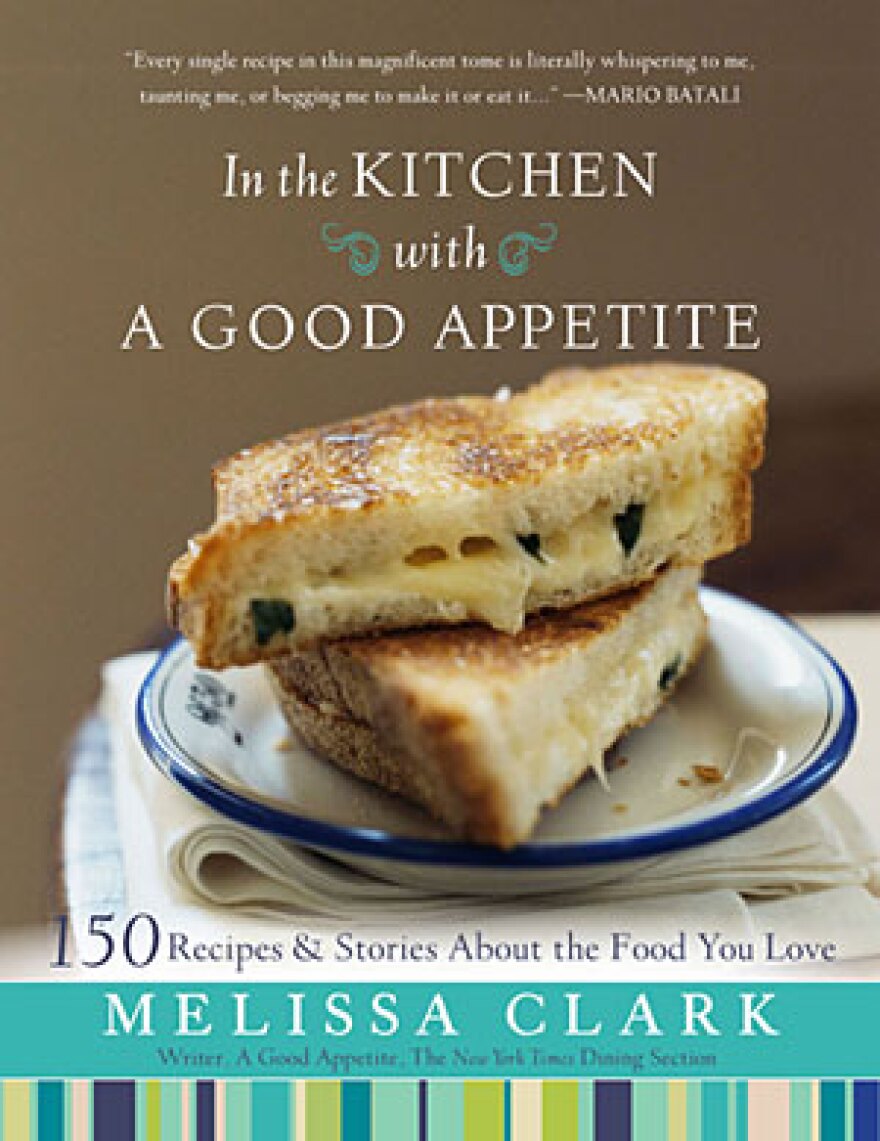
Working Mom Seeks Tasty Recipe Or 2 ... Or 150
In the Kitchen With a Good Appetite, by Melissa Clark, hardcover, 464 pages, Hyperion & Co., list price: $27.50
Melissa Clark has worked on loads of cookbooks, many of them mastheaded by more famous names like Daniel Bouley, Sylvia Woods and Waldy Malouf. Over the years she's developed some serious chops in the kitchen, and a robust following for her Times Dining column, A Good Appetite. But the new one's different -- a collection of anecdotal essays preceding single recipes. This time, it's personal.
You can tell Clark is a newish mom in this book, because it's full of recipes that don't shackle you to the stove, like Pasta with Turkish-style Lamb Eggplant and Yogurt. (If you've ever made Turkish manti, you'll know 1) why you'd want to experience those flavors over and over again, and 2) how badly you need a way to do it that takes less than three hours.) Recipes like the one-pan Roasted Spiced Cauliflower With Almonds almost make a mockery of cooking, but in a nice way. And if you try the ridiculously easy, ridiculously addictive Salted Maple Walnut Thumbprints? Do it in private, because you're not going to want to share them.
I can't quite make up my mind what I like best about this book -- the easy, works-every-time recipes or the all-too-human stories that go with them. But if you're one of those skeptics who think food writers ought to keep their sticky little laptops out of the book biz, all I can plead is this: Give us a try -- you may surprise yourself.
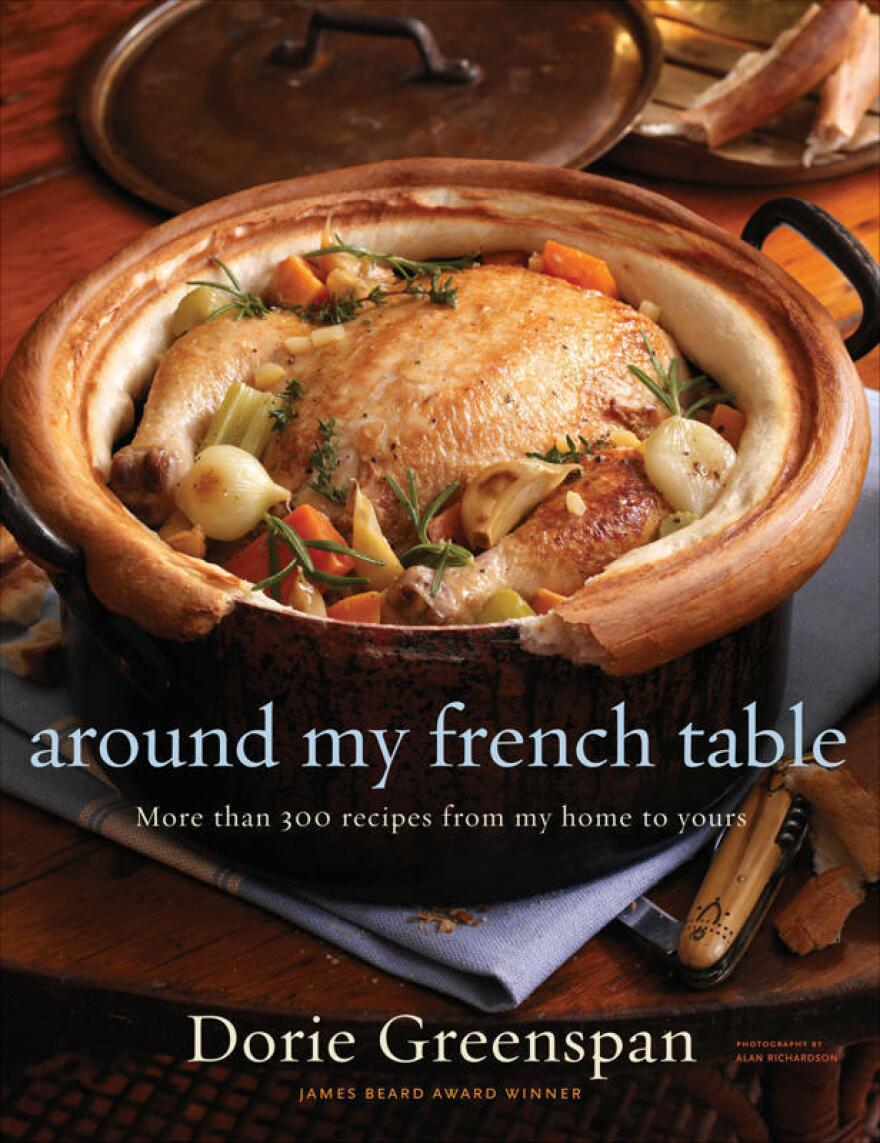
D Is For Disarming
Around My French Table: More Than 300 Recipes From My Home to Yours, by Dorie Greenspan, hardcover, 544 pages, Houghton Mifflin Harcourt, list price: $40
Is it fair for a gifted baker to also be a really, really good cook? I thought there were rules about this sort of thing. Dorie Greenspan has written one brilliant baking book after another -- but now, it turns out, she's been secretly batting for the other team, too. And it's a French cookbook, no less. Maybe that's what happens when you live part-time in Paris and have some hours to kill between making the millefeuille and the vol-au-vent. I don't know; I'll have to try it sometime.
Regardless, Around My French Table is an easier, more inviting and relaxed book than one would have any right to expect from an expatriate patissiere. Sure, there's a profound reverence for butter and frequent salutes in the direction of pork (hello, Cauliflower-Bacon Gratin!), but Greenspan's France is a country in the midst of rapid, cross-cultural experimentation and evolution. Scallops With Caramel-Orange Sauce, for example, she dreamed up after an encounter with two newish Parisian sweet-savory dishes; it's upscale but also swift -- or, as Greenspan puts it, "it takes less time than a hamburger." Similar cross-fertilization is going on in the sour-sweet Lamb and Dried Apricot Tagine, which deserves to be an instant classic (well, not quite instant -- two hours, say, mostly unattended).
Around My French Table doesn't really need my endorsement. It's got gorgeous pictures, great head notes and splendid recipes. It's already on the Times best-seller list. But then, everybody loves a winner, and I reckon you will, too.
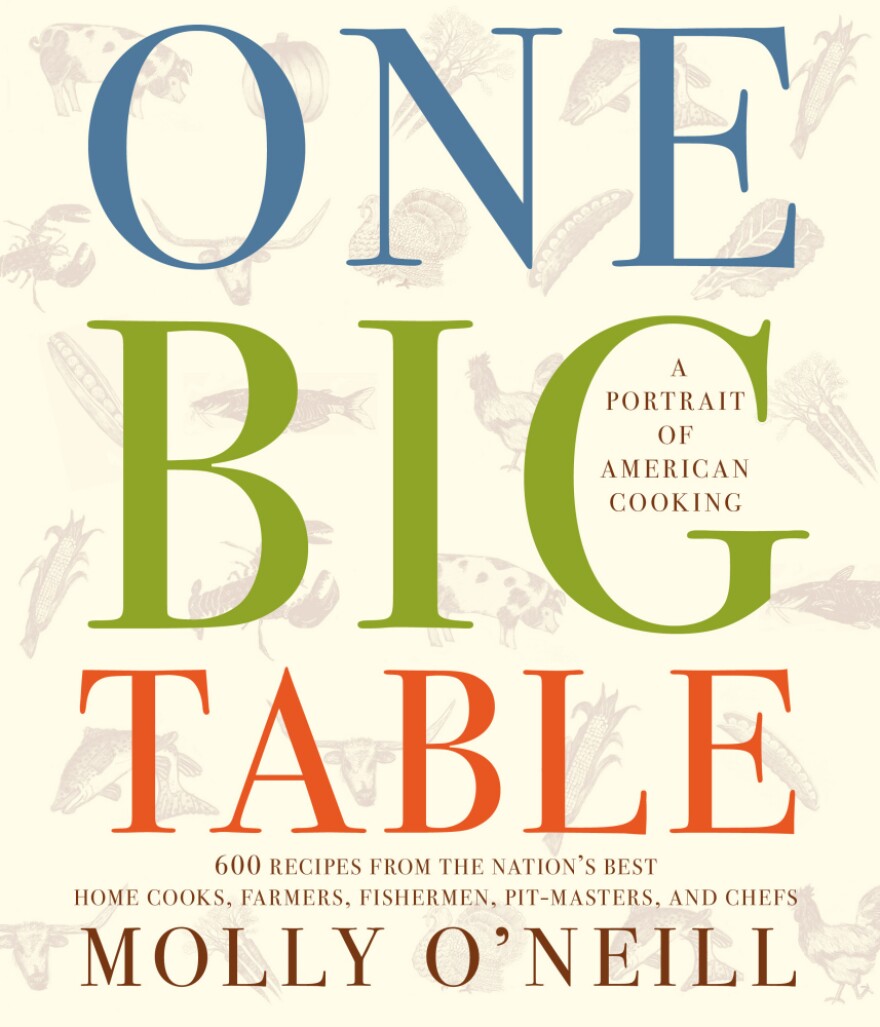
One Nation, Irresistible, With Lemonade And Gumbo For All
One Big Table: 600 Recipes From the Nation's Best Home Cooks, Farmers, Fishermen, Pit-Masters, And Chefs, by Molly O'Neill, hardcover, 880 pages, Simon & Schuster, list price: $50
One Big Table: A Portrait of American Cooking is not just a cookbook, it's an Event. Ten years in the making, it's the magnum opus of former Times columnist Molly O'Neill. And what a work it is! Every page features extraordinary recipes from ordinary kitchen tables all across America. There are a few celebrities (Alice Waters, Andre Soltner) to be sure, but mostly these are the unsung food heroes who feed their families and friends to private acclaim in the small towns of our country.
The collection is wildly abundant and splendidly diverse. Some are shaped by geography, like Boombastic's Scallops From Nantucket (the Boombastic is a fishing boat). Many are cultural legacies, like Mitra Stricklen's Khoresht Bademjoon (Persian eggplant stew). How O'Neill contrived to find all of these far-flung culinary heirlooms surpasses my understanding -- but I bet that you, like any good American, will be instantly prepared to adopt them as your own.
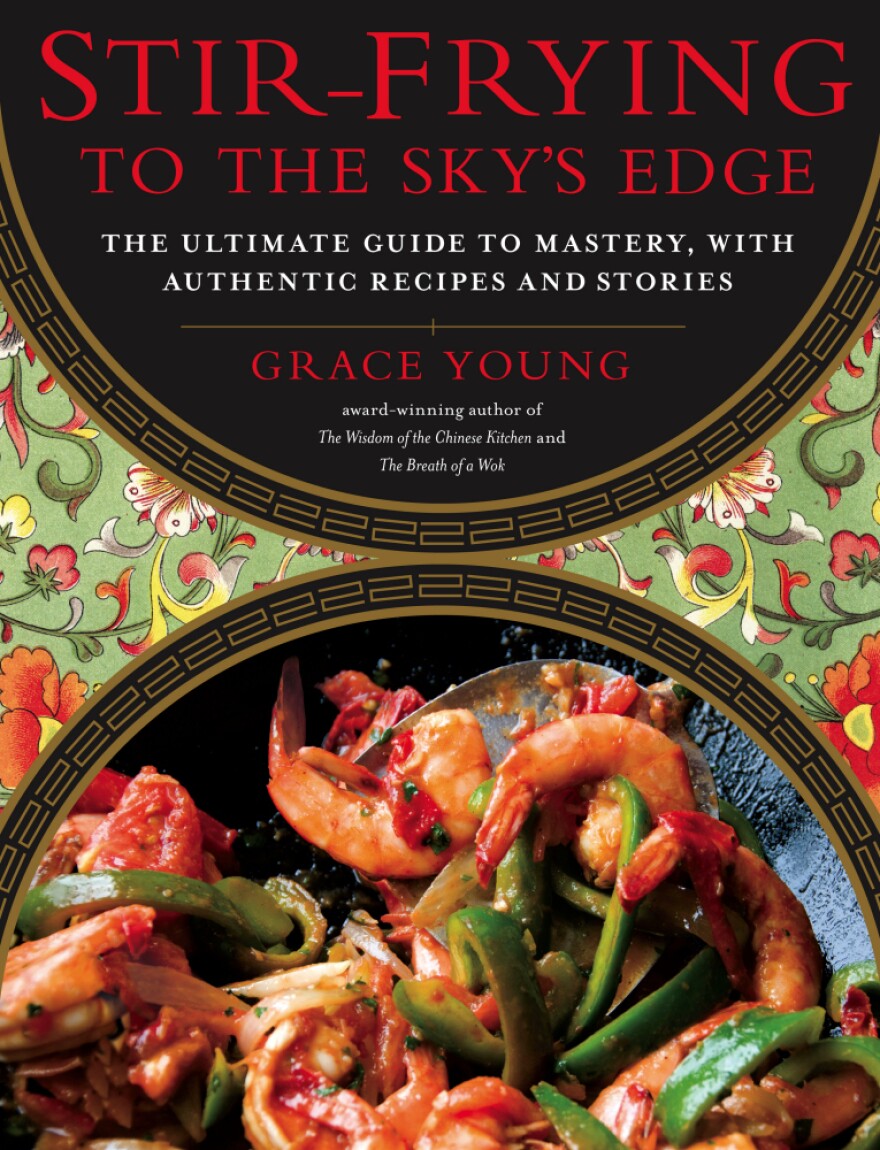
1 Wok, 5 Minutes, 100 Dinners
Stir-Frying to the Sky's Edge: The Ultimate Guide to Mastery, With Authentic Recipes and Stories, by Grace Young, hardcover, 336 pages, Simon & Schuster, list price: $35
I know you thought you already knew how to stir-fry -- it's just ginger, garlic, soy sauce and a wok, right? Wrong! ... if you heed Grace Young, whose previous cookbook taught a lesson to those of us who thought a wok was just another pan. Young's thorough yet streamlined book zooms in on the minutiae of the correct stir-fry -- from how to chop your protein to what to listen and look for in the pan. But her book is broad as well as deep, offering panoramic views of the universe of stir-fry from Singapore to Astoria. Sure, there's some familiar mainland dishes, like the quintessentially Sichuanese Spicy Dry-Fried Beef, or Fried Sweet Rice With Sausages and Mushrooms from Guangzhou. But there's also postings from outposts of stir-fry you'd never have guessed -- they're Chinese Cuban, Chinese Burmese, Chinese Jamaican, Chinese Vietnamese, Chinese Trinidadian.
Indeed, you could just skip cooking altogether and spend a week happily reading the profiles of home cooks and Chinese cultures that Young visited over the years, like some itinerant apprentice monk of stir-fry. So jam-packed is this book with stories, tips and fascinating asides that until a month after I finished the testing I didn't realize two of my own relatives were in it (sorry, Aunties).
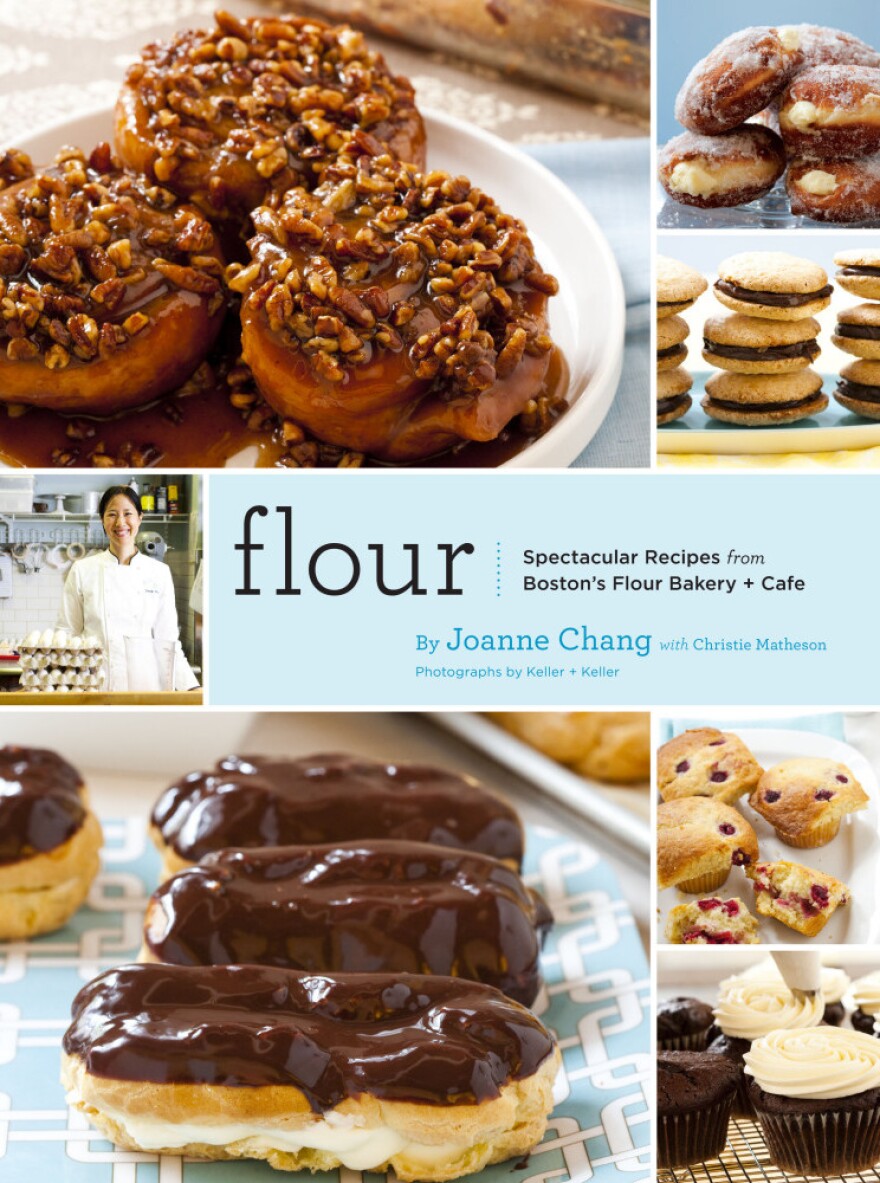
Baking For Highly Effective People
Flour: Spectacular Recipes From Boston's Flour Bakery + Cafe, by Joanne Chang, hardcover, 320 pages, Chronicle Books, list price: $35
What would it be like if you could get one of your smart college friends to start a cookie business, and then a restaurant, and then work for the best patissiers in the business, and then open her own bakery -- or two? What if she then took everything she'd learned at light speed and taught it to you in real time, in a way you could understand? That's what this book is. It's hard to believe that Flour is Joanne Chang's first book, because the level of mastery, precision and experience in it make it feel like the work of someone who's been showing new bakers the light and the way for a very long time.
But it's also a book for the ambitious home baker, the one who's unafraid of a challenge as long as she's got a trusty guide. You can make lofty and delicious Pumpkin Muffins With Candied Pumpkin Seeds, if you don't mind starting the night before so the seeds have a chance to dry. You can make your own almond paste -- really, it's easy! -- for Almond Macaroons With bittersweet Chocolate Ganache. You can even make croissants, if you can hold it together for four pages of lucid, meticulous instruction. Or, if you're too busy for that, thank you very much, you can make something that takes less than an hour, like Buttermilk Biscuits With Parsley and Sage, and still make everyone think you're a baking goddess.
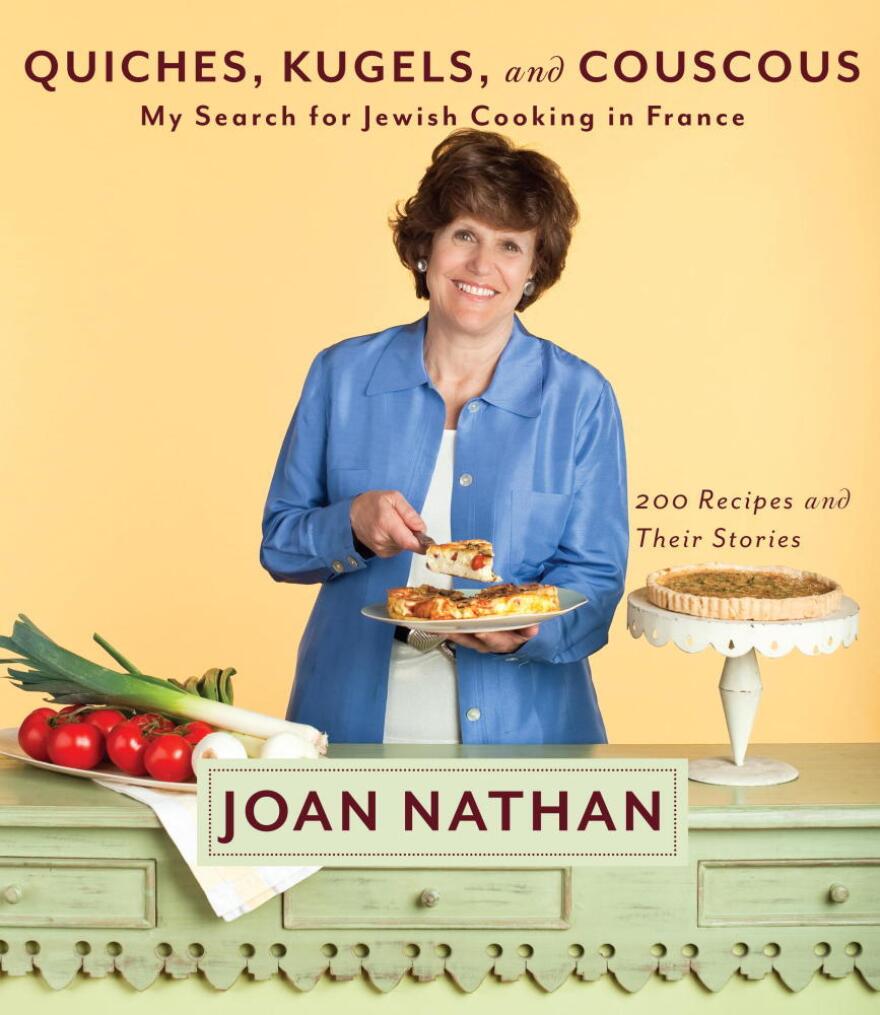
Mastering The Art Of French ... Kugel?
Quiches, Kugels, And Couscous: My Search for Jewish Cooking in France, by Joan Nathan, hardcover, 400 pages, Knopf, list price: $39.95
Joan Nathan is no stranger to the in-depth cookbook; you might know her books on Jewish cooking in the U.S. and Israel, or the ambitious yet approachable The New American Cooking. Her latest effort takes readers on a slow journey across France, in the fragrant footsteps of a diasporic cuisine.
Over two millennia of flight and settlement, the Jews of France adapted in uncountable delicious ways. Yet generation after generation managed to maintain a distinct culinary identity in a country that has always been one of the most pork-loving on earth and which, even today, hasn't got the kosher food factories familiar to those in the U.S. There are French standbys that have been Judaized, like a ham-less quiche Lorraine (Quiche a l'Oignon). There are happy comminglings of Ashkenazic, Sephardic and regional traditions, as in a Brisket With Ginger, Orange Peel and Tomato. There's Alsatian kugel, there's haroset from Bordeaux -- but best of all, there's a wealth of stories, memories and legacies that guarantee that this culture will continue to thrive in far-flung kitchens.
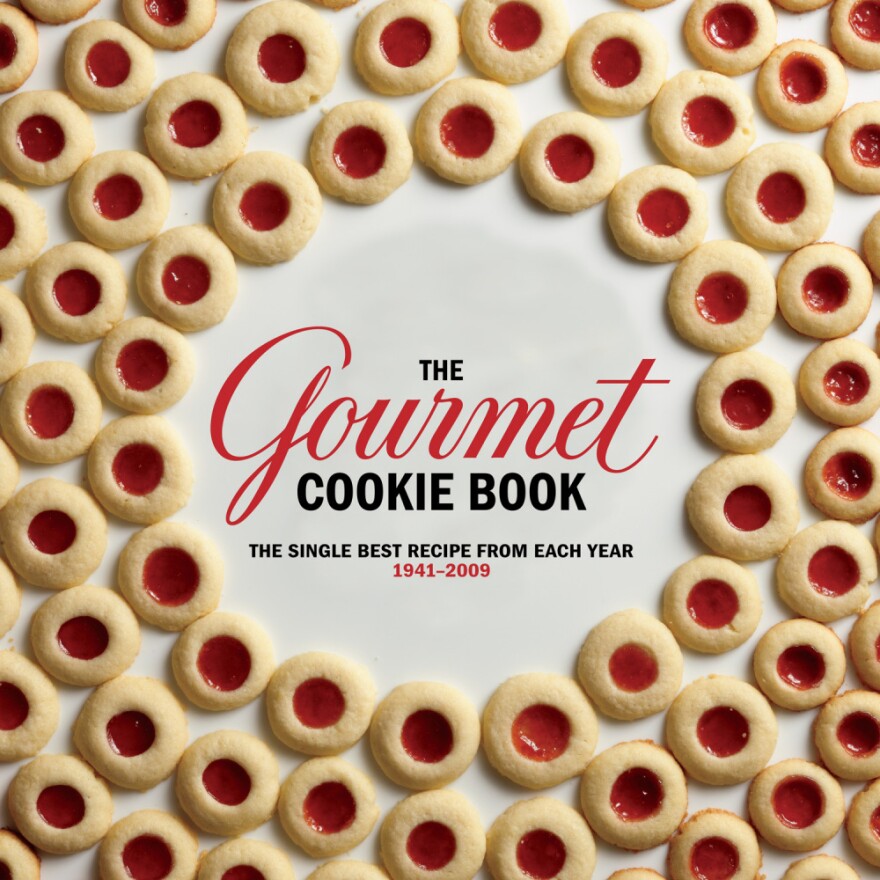
You Had Me At Biscotti
The Gourmet Cookie Book: The Single Best Recipe From Each Year 1941-2009, by Gourmet magazine, hardcover, 176 pages, Houghton Mifflin Harcourt, list price: $18
Your heart's still aching, I know, over the loss of Gourmet magazine. But I'm happy to say that dozens of bite-sized consolations are on their way even now. The editors of that much-mourned periodical have dredged the archives, emerging flour-dusted and sugar-caked with what is clearly the stocking-stuffer of the year for your favorite baker.
It's a minimal book -- a single favorite cookie recipe from each year -- but it's captivatingly designed. Geometric cookie designs adorn each facing page, their elegant disposition giving you a sense of how cutting-edge, how fashionable they must have seemed in 1948 (Jelly Centers), in 1976, (Lemon Thins), in 1997 (Chocolate Coconut Squares), in 2008 (Glittering Lemon Sandwich Cookies). It may have taken 70 years to distill this slim book of treasures, but it'll take you only 15 minutes at 350 degrees to re-create a batch or two of irresistibly sweet memories.
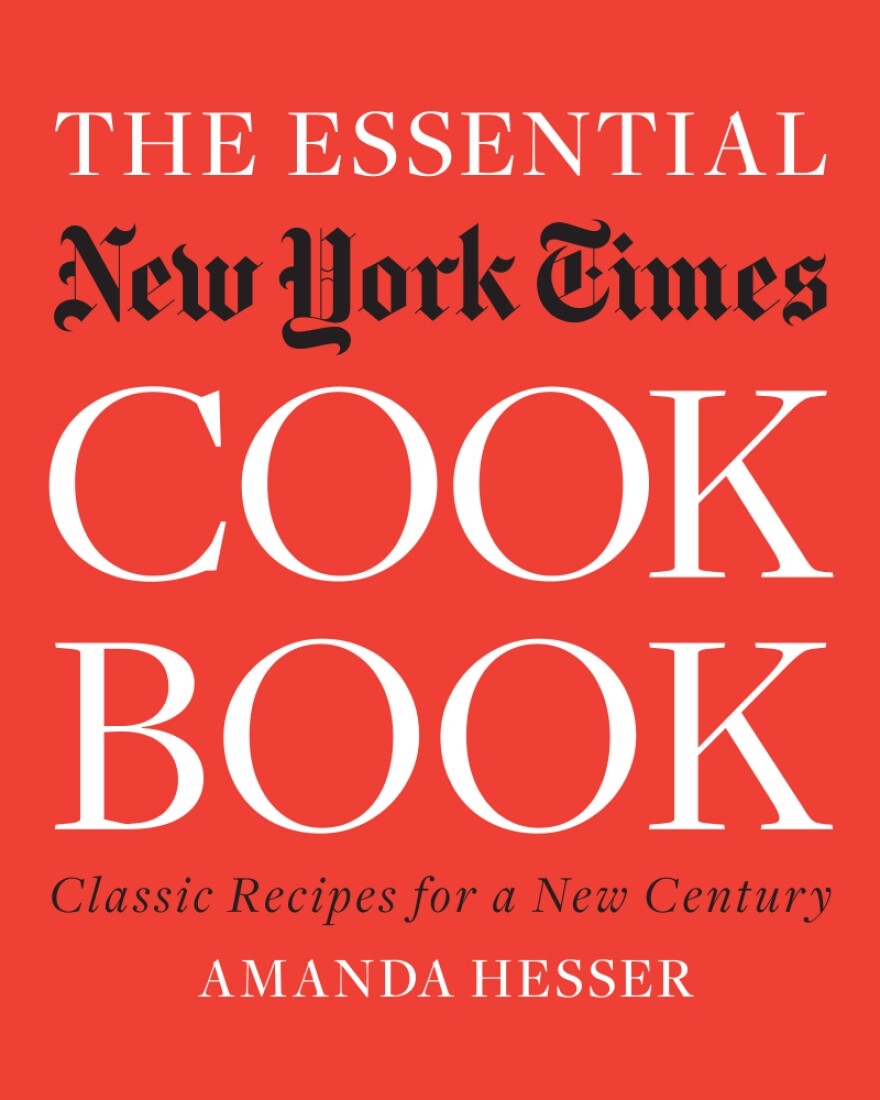
All The Food That's Fit To Eat*
(*Not my pun, sad to say, but a title once proposed for the book.)
The Essential New York Times Cookbook: Classic Recipes for a New Century, by Amanda Hesser, hardcover, 932 pages, W.W. Norton & Co., list price: $40
On first sight, The Essential New York Times Cookbook looks like one of those big, basic cookbooks -- it's about the size and heft of a Joy of Cooking, or Cooks Illustrated's New Best Recipe. Don't be fooled, though. This is not the book you used to give your new graduate so she could learn how to make chicken stock, or to show you where on a steer you could find the rump roast. Although some of the preliminaries (Fried Eggs! Scrambled Eggs! Poached Eggs! Plain Omelet!) are covered, Amanda Hesser's selection of recipes definitely addresses what happens when you get beyond salt, pepper and olive oil. It's not so much a "How To" as a "What's Next?"
It's fascinating to see how the Times dining section answered that question -- What's Next? -- for 150 years. Fresh Mushrooms Stewed With Madeira (dating from 1897) still seems like a good idea, as does the forward-looking Chicken Canzanese (with prosciutto and chile and herbs) from 1969. But while the historical recipes may come off as quaint or remote, the book also acts as an unself-conscious snapshot of what people find interesting today -- i.e., the expanded ingredient list, the more ethnically diverse vocabulary. Where you might have once learned to make creamed spinach, you now have Steamed Spinach With Balsamic Butter. Instead of fried pork chops, Pork Arrosto With Prunes and Grappa.
Hesser's idiosyncratic and often charming voice introduces every recipe, which can be a little distracting, given that the recipes are not actually her own. That doesn't diminish the pleasure, however, of her occasional zingers, like "A good recipe may have a thousand fathers, but a bad one is an orphan."
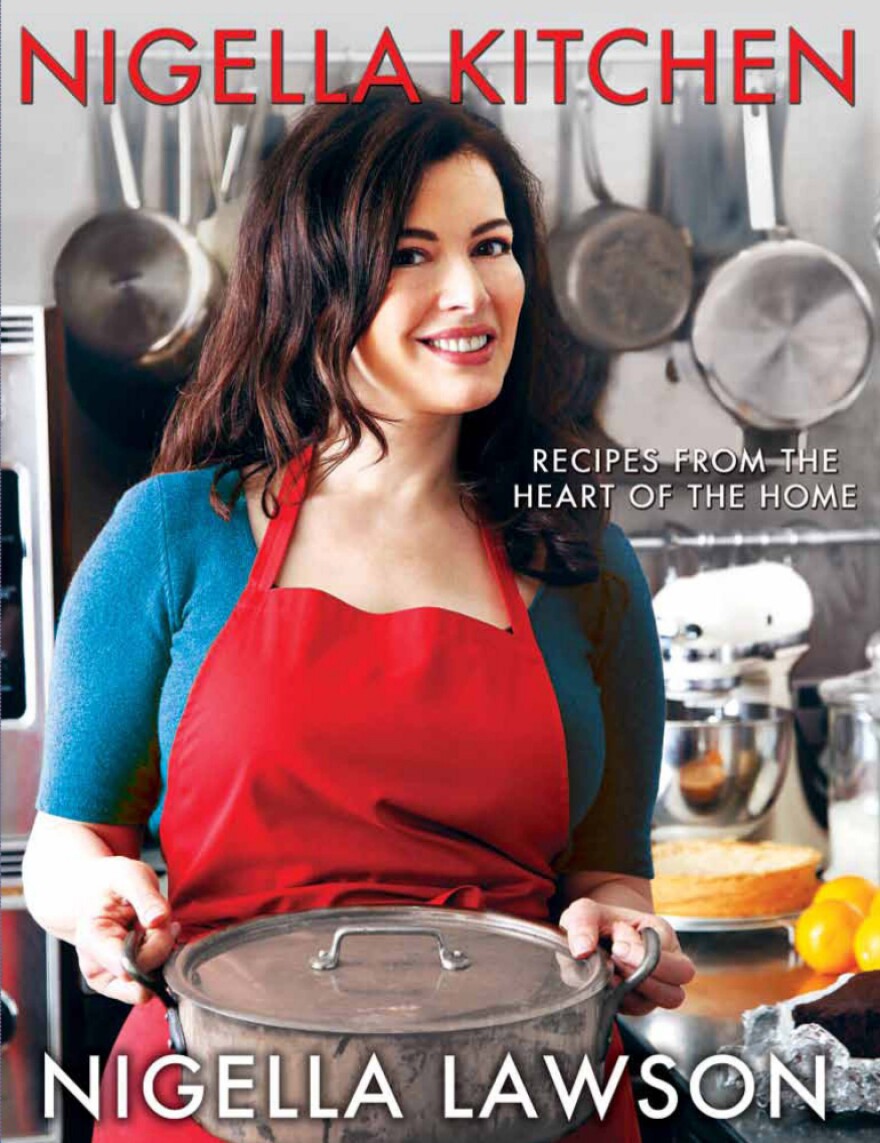
Just Another Weekday, Just Another Mom
Nigella Kitchen: Recipes From the Heart of the Home, by Nigella Lawson, hardcover, 512 pages, Hyperion & Co., list price: $35
For many of us, it's hard to face another Nigella book without feeling a twinge of anguish -- how is it possible to be so successful, so photogenic, so prolific? Yet each time you have to forgive her her superlativeness, because she really is a good cook with a steady stream of ideas, and you can tell she doesn't delegate the cooking to a squad of interns. And though I hate to admit it, I'm kind of a sucker for her jumbled, ornamental prose stylings: "... not just a good way of using bread past its bouncy best, but also a jubilant end for a handful of tomatoes so old they're moving beyond ripeness and towards skin-splitting, fuzzy-fleshed maturity." Aren't we all!
These recipes are meant to capture typical nights with kids in the Nigella household, and it has a casual and slightly tousled feel. The sweets and vegetables seem to be haphazardly distributed it among the mains and sides. But for the most part, they look like get-it-done, feed-the-kids, high-flavor mash-ups. Butternut, arugula, and pine nut salad makes for such an agreeable entente of contrasting textures and flavors that it's hard to believe it's not a bistro standard. And it would be hard not to be charmed by the visual pun posed by equal-sized squid and rigatoni rings in her Quick calamari pasta.
Like it or not, the lushly adjectival Nigella industry is still going strong -- and like it or not, we ordinary non-supermoms still stand to benefit from it.
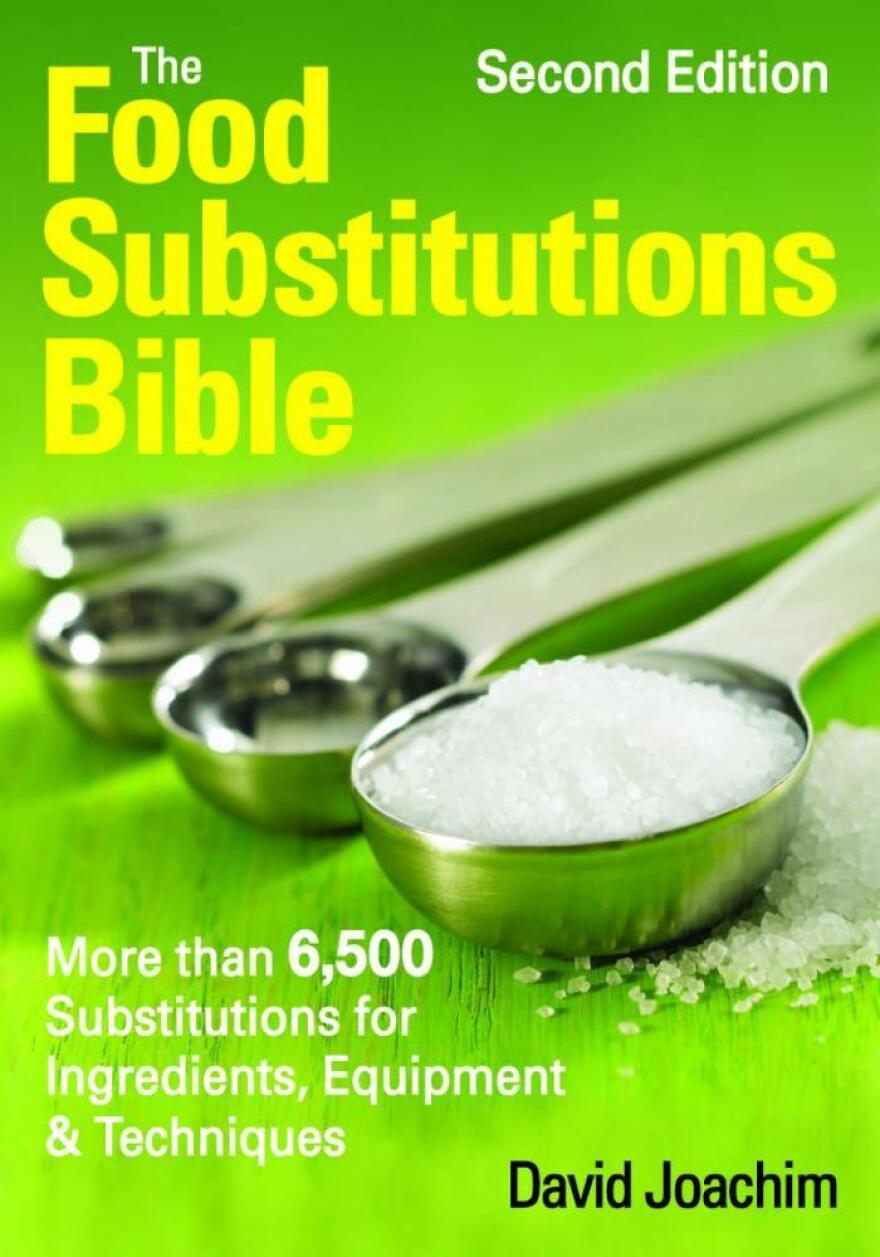
Oh No! We're Plumb Out Of Lamprey!
The Food Substitutions Bible: More Than 6,500 Substitutions for Ingredients, Equipment And Techniques, by David Joachim, paperback, 696 pages, Robert Rose, list price: $24.95
Okay, I know, I know, it's not a cookbook! But if you don't have the Food Substitutions Bible, you definitely need it. Maybe you have a weakness for ethnic cookbooks: How many times have you gotten halfway through a recipe only to discover that it has annatto seeds, and they're not "(optional)"? Or you rule out recipe after recipe because you don't happen to have confectioner's sugar on hand (it's just regular sugar plus corn starch, folks!)
Then there are those pantry ingredients you use so seldom you can never really remember if you have any left, so you forget to pick them up at the store. Like allspice (substitute cinnamon and cloves) or powdered mustard (use regular mustard and leave out liquid elsewhere in the recipe). Or your creme fraiche expired a week ago -- in which case, there's at least five different dairy solutions that will work in a pinch. (Read some of David Joachim's savvy substitutions here.)
This is the second edition of the most frequently-used book in my kitchen, and it reaches into some of the farthest corners of culinary obscurity. It's the perfect gift for those friends who lie awake wondering What, oh what, they are going to do when they run out of hyssop? or tatsoi? What about Crocodile meat? (answer: use alligator, turtle, or, failing those, chicken or swordfish) There really are second chances in every kitchen. This book just makes sure you know how to find them.
Copyright 2023 NPR. To see more, visit https://www.npr.org.

